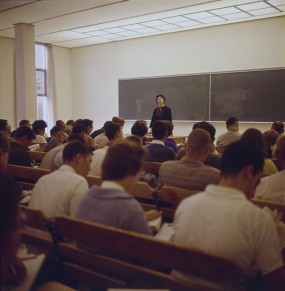This task could function as a personal reflection exercise or a three-part class discussion.
Histories
- List places (regional, national, or even continental) that you consider important to your understanding of your personal, ethnic, and cultural origins (including a few familial generations). Also list other cultural heritages that you consider to have an impact on your sense of self, such as friends or family.
- Consider how these various origins and connections contribute to your sense of self and your view of society. Do you hold particular values dear that others might not? Have you experienced tension or conflict with others because of these various backgrounds?
Classrooms

The classroom is a space where a careful consideration of cultural diversity is important. “Woman speaking at front of classroom facing students.” Government of Canada, Library and Archives Canada, accession number 1971-271 NPC, e010975927-v8
- Importantly, the classroom is not a neutral space, but rather a location where certain differences may be reinforced.
- The What I Learned in Class Today website provides further discussion topics and resources to improve discussions of cultural diversity in the classroom. Its goal is to make classrooms a safe and productive space for all students. It also offers powerful videos of Indigenous students discussing their experiences, illustrating why a careful and articulate approach to cultural diversity in the classroom is necessary.
- Discuss what personal differences and histories suggest about the social climate of the classroom. What do we need to be able to function as a community, to interact and work together? What values must we share? Discuss these communal values and different interpretations of them.
Communities
- What analogies can we draw between the requirements of the classroom and the requirements of the nation? It may be helpful to list features of nations, including borders, governments, and other power structures to draw out these connections.
- This activity should be approached as an opportunity to think about the challenges faced by diverse communities in order to draw out important distinctions and connections, such as those relating to power, communication, and access. These considerations can be employed in the analysis of specific stories or experiences in literary works.
- Note: this may be a helpful forum for exploring the problems of essentialism, and the possibilities of adaptation and hybridity; between static, depersonalized views of ethnic and cultural identity, and more fluid, personal and contextualized approaches. Take this opportunity to explore the tenuous relationship between the policy of multiculturalism and the daily experience of communities.








 ©
©